Addition to the Family
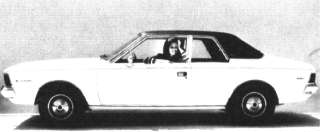
Hornet SST, 1970
There was lots of news in 1970. The American was replaced by a completely new car, the Hornet. It had a modern body with long hood and short rear like many Japanese cars of the late seventies would have.
The Hornet showed AMC's turn back to niche politics. Not only was it available as a stripped and cheap base model, but also a long list of options was offered, and that's what made a difference from the competitors. Everything from base with 3.3l six, vinyl seats and rubber floor mats to luxurious top model with 5 liter V8, cloth interior and carpeting was possible. Even auto trans, disc brakes, air conditioning, reclining bucket seats and vinyl roof could be ordered.
The Hornet also brought back the strategy of parts sharing. 2- and 4-seater were identical up to the roof, and even front and rear bumpers interchanged.
Of all days, it had to be April Fool's day when the Gremlin was presented, the first sub compact car produced in America to compete with the most successful imports, especially the Volkswagen Beetle. The Gremlin was half a year ahead of Ford's and GM's offers in that class — too short a time to sell lots of units, but sufficient to get attention. The Gremlin was a Hornet with the rear cut off (Kamm-back). Remarkably it was only offered with six cylinder engines in a class where the competition almost exclusively had economical four-bangers, but at first that didn't harm the Gremlin's success.
As no comparison to Detroit's products was possible, AMC had a hard time pricing the Gremlin. A placative base price of $1879 was decided. The buyer got an over-stripped car for this money, with front bench seat, rubber mats, and no rear seat — a "business coupe". The main purpose of those business coupes was to be able to claim an extremely low price. Not many of those were ever sold. In 1970 only 879 Gremlins were business coupes. The Gremlin was an instant success and attracted mostly younger people.
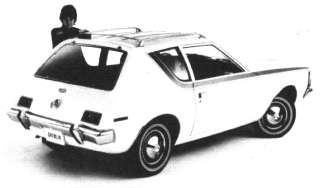
Gremlin, 1970
The rest of the fleet stayed the same. Most interesting newbie was the Rebel Machine, a wiry sports coupe with 6.4l V8 (340hp SAE) aka "Flying Brick". But: something else, something decisive for AMC's fate happened:
The American Motors Corporation (now with new logo, see above) bought Kaiser Jeep for the total sum of $70 million, of which $10 million was cash. Kaiser wanted to abandon the automobile business, and AMC needed a truck. Jeep was a losing company, but Chapin saw its potential, and he was sure that synergy effects of a united development and production would help both companies.
The purchase brought AMC near the debtors' tower again, and Chapin found himself criticized harshly, but his opinion that Jeep would be an advantage for AMC turned out to be all true in the following years. The work on unification and technical compatibility was begun immediately. First the production of military and governmental vehicles was seperated to an own division, AM General (which was sold later and still produces the Hummer!).
"If you had to compete with GM, Ford, and Chrysler, what would you do?" asked AMC in brochures and TV ads, and provided the answer for each model instantly:
You'd introduce the Matador. A car that even the dollar-conscious family man would find hard to resist.
You'd start a small car revolution by coming out with America's first subcompact: the Gremlin.
You'd give the Hornet standard features you wouldn't find on the Maverick.
You'd make the Ambassador the only car line in America with air-conditioning and automatic transmission as standard equipment.
You'd make the Javelin the hairiest looking sporty car in America, even at risk of scaring some people off.
You'd design the Sportabout. A car that could do more for the American housewife than all the haircoloring, lip gloss and false eyelashes put together.
Imagine one of the last two in a commercial of today! These statements leave nothing to say short of a few details:
The Javelin got bigger (and sold worse, seems they still hadn't learned their lesson) and now featured humpster fenders; the AMX was degraded to a mere variant of the Javelin. The SC/360 Hornet was presented to line up in a row with SC/Rambler and Rebel Machine. The 3.3l six was discontinued which made the 3.8 the base engine. The latter was accompanied by the 4.2 six, same engine, but longer stroke. The Gremlin was offered with "X-Package", a hot seller. It consisted of front bucket seats, carpeting, alloy wheels, painted grille and sidestripes and made a little racer out of the car.
What didn't fit into the picture were relicts of former times like 3-speed manual trans with unsynchronized first gear and those infamous vacuum wipers.
The new thing of the Matador was its name. It was basically the good old Rebel and offered in body styles hardtop coupe, 4-door and station wagon.
Jeep's productivity was improved, engine program was AMC-ized, and from now on Jeeps were sold by American Motors dealers. The appreciated styling was kept.
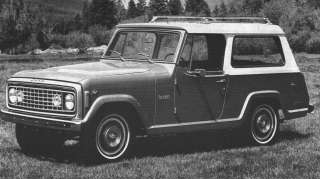
Jeep Commando, 1972
Also kept was the whole line for 1972. Most important changes happend below the surface and in marketing. "Quality, value, costumer satisfaction" were the key words. The dated Borg-Warner transmission was replaced by a modern Chrysler unit, wipers were electric now. The stripped base models were dropped. Instead the Gremlin could now be had with 5.0 V8. A new quality management was introduced to reduce warranty claims. Heavily advertised and generally appreciated was the Buyer Protection Plan. It consisted of:
- a strong guarantee
- more thoroughly checked cars
- a loaner car when necessary
- a toll free hot line to Detroit (AMC headquarters)
This quality offensive came to the right time, because many Americans were fed up with the horrible quality of domestic products and more and more decided to buy Japanese and German. With this plan AMC was able to gain a better place in the market and go into 1973 with excellent numbers.
The Climb to the Precipice
Roy Chapins credos for the following years were: philosophy of difference and diversification. The first one meant that AMCs had to be different to be able to survive on the market, the second one reminds of the ideas of a certain Mr. Edzard Reuter who would a decade later also be of the opinion that a car manufacturer needed to go into other markets to survive. Had he took a look at AMC, maybe some things would have turned another way for Daimler-Benz.
AMC's Debis consisted of AM Data Systems and American Motors Leasing Corp., instead of AEG they had the plastics companies Evan Products and Winsor Plastics. The pendant to DASA wasn't a plane manufacturer but a steel casting company, Holmes Foundry Ltd., Canada.
AM General just had started developing busses, a field so far left alone to GM and Flxible and promising to grow, considering crowded streets, polluted air and dated fleets of the providers of public transportation.
The Hornet got a new body variant that thus far only foreign manufacturers had been offering: the Hornet Hatchback. The old 3-speed was replaced by a fully synchromesh one. The Levi's Gremlin was presented. It featured an interior made of jeans cloth (or at least something that looked like that). The Hornet Sportabout was offered as Gucci Sportabout with an interior designed by star-couturier Aldo Gucci.
The pony car market was nearly dead, thus Javelin and AMX were continued, but no longer subjects of major changes. The Javelin, too, got a touch of pret-a-porter: a fancy interior by Pierre CARdin made it the Cardin Javelin.
Matador and Ambassador were continued without letting any maestro touch their interiors.
Subjects of the most thorough changes were the Jeeps. New instrument panels caught the eye, but more importantly the permanent all-wheel drive Quadra Trac was introduced in J-series pickup and Wagoneer (predecessor of the Grand Cherokee). The CJ was available with a powerful V8 as an option.
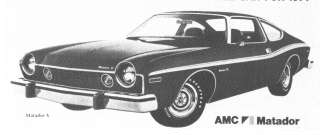
Matador Coupe, 1974
1974 was a year of change. Matador and Ambassador were due to retire. The successors should share the same platform and get a new look that just started getting popular in the USA: Mercedes-look.
Despite that role model the new Matador got one of the most ugly cars ever to roll off the assembly lines as Kenosha. Dick Teague had lengthened the hood by far, but to save costs the fenders had to remain. The sum of these parts looks funny at best.
But where had all the money gone? Well, market research had discovered that the public in times of recession didn't desire anything more than a pretty middle class coupe, and that the Matador Hardtop was being too conservative. AMC's leaders noted that fact and immediatly junked all the experience they should have made in the past. An all-new coupe was designed, a car that shared no single body part with others and thus was extremely costly to design and produce. The Matador Coupe received the title "1974's best styled car" by magazine Car & Driver and not only got AMCs second biggest flop but also one of the two cars that in the end broke the neck of the company. It sold well at first, but never well enough to pay back its costs. And there was no further money for the facelifts necessary later on.
All other cars didn't change much. The Jeeps sold fine and earned the money that was wasted for the other vehicles. The new Cherokee was a best seller from the beginning, and the Wagoneer was alone in its class .
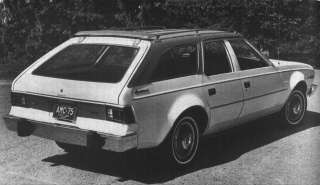
Hornet Sportabout, 1975
The increase in Matador Coupe sales that was expected for the following year didn't come. But there was another ace hidden in AMC's sleeve that all efforts concentrated on: a new compact car between the Gremlin and the Hornet, a car unlike any other car, a car representing AMC's philosophy of difference like no other: the Pacer. In its first year the car selled so hot that production couldn't cope. All other models hit 1975 like they left 1974. Gremlin and Hornet were already six years in production and prone to go to auto heaven, but had to be carried over. The Ambassador was discontinued, big AMCs now went by the name of Matador. Javelin and AMX were dead.
Sales numbers of the Matador Coupe already decreased, short of the Pacer the dealers sat on a pile of cars they could hardly get sold. Chapin reacted by severe cost control management. The Gremlin got a minor facelift and was positioned as lowest priced car produced in America. The new Jeep CJ-7 was introduced. It was a bit longer than the CJ-5 and thus allowed to be equipped with permanent AWD and automatic transmission. AM General made good profits with busses and military vehicles, and subsidiary Wheelhorse Tractors was successful, either.
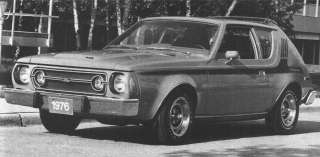
Gremlin, 1976
In 1977 nobody could foresee that the Pacer would be the last car to be completely developed by American Motors itself. All vehicles were carry-overs, no changes could be made. Pacer sales were dropping, almost nobody ordered the Matador Coupe anymore. People had started looking for more economical alternatives and found them in the products of Japan and Europe. AMC had nothing to offer below the 3.8l I6 and no money to develop a 4 cylinder engine of its own. To help this shortcoming it was decided to buy one. The engine of choice was Audi's 2.0, of which AMC bought the rights to produce it itself. This was a good although not greatly cultivated motor that in Germany powered numerous Audis, the Volkswagen LT (a 3 ton truck) and the Porsches 924 and 924 Turbo. Famous for its torque and durability this engine was prone to turn the Gremlin into a fuel saver. But: instead of Bosch's K-Jetronic AMC put a crappy carburetor on the engine. This along with America's lax production tolerances made a tired, rough rattler out of this talented engine. The strong vibrations were hidden by extremely soft motor mounts which made an idling 2.0 do the mashed potatoes in the Gremlin's engine compartment. The production of the engine was more expensive than the production of the small six, so the standard engine still was the 3.8, only higher versions got the smaller engine.
A Wagon was added to the Pacer line and helped sales somewhat. The Hornet Hatchback got a sporty AMX package.
Jeep sales saved AMC from going down right now.
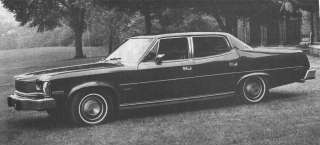
Matador Sedan, 1977
William Luneburg, president of American Motors Corporation, retired in May, 1977 and was replaced by Chapin's long-time confidant Gerald C. Meyers. AM General got a big order to produce military vehicles. All divisions short of car production were in the profit zone. After all, a net profit of $8 million was made. Peanuts compared to a sum of one billion US dollars that Ford Europe had invested in the development of the new Fiesta.
Schuss
Things that did not come in 1978:
- A new subcompact below the Gremlin. Too high the cost, too low the gain.
- A four door version of the Pacer. Pacer was a sinking ship.
- A restyle of the Gremlin featuring a thinner C pillar and larger glass area that would have looked chic and modern at low tooling costs. There was no reason for not doing this. Oh well!
- A sporty coupe on base of the Gremlin similar to the Toyota Celica.
What did come was the Concord, after all a Hornet with newly designed front and rear, improved suspension and noise isolation. All that gave it the look and feel of a higher class, and to emphasize this a new name was chosen. It made sense to position the car higher as it saved it from having to directly compete with the Japanese cars.
The press honoured the new product, but not to an extent that would have made the Concord appear on front pages. Despite that it brought people back into AMC dealers' show rooms where they didn't find anything to put them into kaufrausch (strong, ecstatic inclination to buy something).
The Matador in gordy "Barcelona" trim scared potential buyers off. Decreasing demand for Matador sedans and hardtops was compensated by cutting numbers of variants, only the 4.2 six and 6.1 V8 were still available.
Pacer sales were down in the cellar, even the facelift and the V8 option couldn't get them back up. The Gremlin was still there, now as GT with lots of plastic body wideners.
The Hornet AMX got the Concord front and now was called AMX without Hornet. It had been more successful than expected in 1977, so it was justified to make it a model of its own, also it revived memories of the real AMX of 1968.
Everything Jeep still was successful and made money. In fact, the Jeep line was so successful that production couldn't cope with demand. As a reaction quantity was increased to an extent that quality went down. Not that a Jeep had been a lemon, but messy paint jobs and switches and buttons falling off weren't prone to increase customer satisfaction.
As a consequence priorities were shifted. Car production was moved completely to Kenosha, all other factories now made Jeeps. So not only more could be produced, but also more efficiently.
In the end of 1978 Roy Chapin retired. His job as chairman and CEO was taken by Gerald Meyers who continued politics. The stock holders received a strange message with this year's annual report:
We have put our house in order so we can proceed with a fundamental part of our strategic plan — to become a member of the group of worldwide auto companies that will be competitive in the years ahead. During 1978 we have conducted intensive negotiations in this regard with Renault.
This was meant to get two flies at one hit: AMC's vehicles, especially the Jeep line, were to be sold via a great dealer network in Europe and thus find much more buyers than before. And AMC was to get a competitive compact car which it could no longer develop by itself. Negotiations with Honda and Peugeot (which had troubles galore with struggling Citroën at that time) didn't work out, but Renault showed interest.
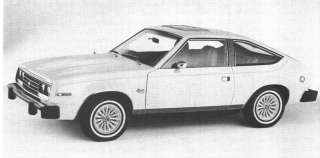
Spirit, 1979
The model year 1979 was begun with lots of optimism. The Spirit was introduced. It was based on the Gremlin, a fact that could not easily be recognized, especially when looking at the hatchback version, although doors, fenders and hood were identical with the Gremlin's. The Spirit looked like an entirely different car — once again a masterpiece by the hands of Richard Teague. The spirit got similar enhancements as the Concord had got which made it even more attractive.
The Concord was back again, slightly changed and available as D/L and Limited with all imaginable luxury and electric helpers included. The Matador was discontinued, the biggest AMC cars now went by the name of Concord.
No major changes were made to the Jeep line, neither would they have been necessary. The Cherokee station wagon was sold out for months. Cherokee line was available in different trims (Chief, S, Golden Eagle). All big Jeeps got a new front design with rectangular headlights. The 25th anniversary of the CJ was celebrated with the Silver Anniversary CJ, the 25th anniversary of American Motors with the Silver Anniversary Concord. Both were painted silver metallic (duh!) and got anniversary badges.
The First Renault
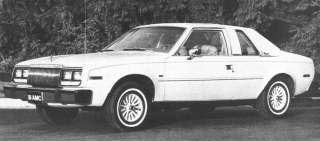
Concord DL 2door, 1979
The deal was made. From now on Renault sold Jeeps via its dealer network in France and Columbia, and Renaults were being sold via AMC dealer network, first model was the LeCar (Europe's R5). Furthermore AMC and Renault planned to cooperate in the development of a model between the R5 and R18 that was to be assembled by AMC.
Rumours about AMC's car production to be ceased were denied vehemently. New prototypes were being tested already, the program for 80/81 was decided, AMC stated. A 4 cylinder CJ was planned, and as the Audi engine offered too little torque the contract was terminated and a 2.5l four suitable for CJ, Concord and Spirit was bought from GM. The plant in Western Virginia that since had produced Pacer body parts was sold to Volkswagen. No seperate plant was necessary for so few Pacers that still could be sold.
The second oil crisis hit AMC hard as it mostly cut down sales on the SUV market. Suddenly Jeeps stood their tyres flat at AMC dealers' yards. At times assembly line workers had to go on vacation to not produce too much on stack.
AM General was in good health thanks to huge orders of military and postal vehicles.
In October it was announced that Renault was about to buy some AMC stock summing up to 22.5%. Suddenly a French sat in AMC's board. This step had become necessary because of money problems. Without cash there was no possibility to prepare the factories for the production of the new AMC-Renault. Tooling, renovation and acquisiton of assembly robots were costly.
